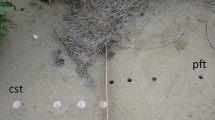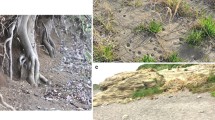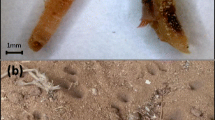Summary
Larvae of Myrmeleon immaculatus in large pits captured both large and samll prey, while larvae in small pits captured only the small prey. Larvae in small pits did not respond to large ants, although they always responded by sand-flinging to small ants. Larvae in medium-sized pits often captured large ants only after prolonged and vigorous sand-flipping. Larvae in large pits usually captured large ants with relatively little sand-flipping. Pit enlargement and pit relocation in the laboratory were not significantly correlated with reduction of rations in the first 3 weeks after a pit was built. However, after a month without food, larvae on the average moved once every 10 days, built successively smaller pits, and moved longer distances before building a new pit. In the field pits were dug primarily in response to microclimatological factors and possibly edge-effects. The presence or absence of suitable prey at a site, per se, had no effect on whether or not a larva would dig a pit there. We conclude that these sit-and-wait predators have a relatively large repertoire of behavior that enhances their foraging success, and we contrast it with previously made optimal foraging models relating to pit locations, pit relocations, pit size and ant lion responses.
Similar content being viewed by others
References
Doflein F (1916) Der Ameisenlöwe, eine biologische, tierpsychologische und reflexbiologische Untersuchung. Fisher, Jena
Eppstein MJ, Heinrich B (1981) Pit-trapping as an optimal foraging strategy by ant lions. Am Zool 21:995
Griffiths D (1980a) The feeding biology of ant lion larvae: prey capture, handling, and utilization. J Anim Ecol 49:99–125
Griffiths D (1980b) The feeding biology of ant lion larvae: growth and survival in Morter obscurus. Oikos 345:364–370
Koch M, Bongers J (1981) Nahtungserweb des Ameisenlöwen Euroleon nostras Fourcr. Neth J Zool 31:713–728
Lucas JR (1982) The biophysics of pit construction by ant lion larvae (Myrmeleon, Neuroptera). Anim Behav 30:651–664
Lucas JR, Brockman HJ (1981) Predatory interactions between ants and ant lions (Hymenoptera: Formicidae and Neuroptera: Myrmeleontidae). J Kans Entomol Soc 54:228–232
McClure MS (1976) Spatial distribution of pit-making ant lion larvae (Neuroptera: Myrmeleontidae): density effects. Biotropica 8:179–183
Olive CW (1982) Behavioral response of a sit-and-wait predator to spatial variation in foraging gain. Ecology 63:912–920
Turner CH (1915) Notes on the behavior of the ant lion with emphasis on the feeding activities and tetisimulation. Biol Bull 29:277
Wheeler WM (1930) Demons of the dust. Norton, New York
Wislon DS (1974) Prey capture and competition in the ant-lion. Biotropica 6:187–193
Author information
Authors and Affiliations
Rights and permissions
About this article
Cite this article
Heinrich, B., Heinrich, M.J.E. The pit-trapping foraging strategy of the ant lion, Myrmeleon immaculatus DeGeer (Neuroptera: Myrmeleontidae). Behav Ecol Sociobiol 14, 151–160 (1984). https://doi.org/10.1007/BF00291906
Received:
Accepted:
Issue Date:
DOI: https://doi.org/10.1007/BF00291906




